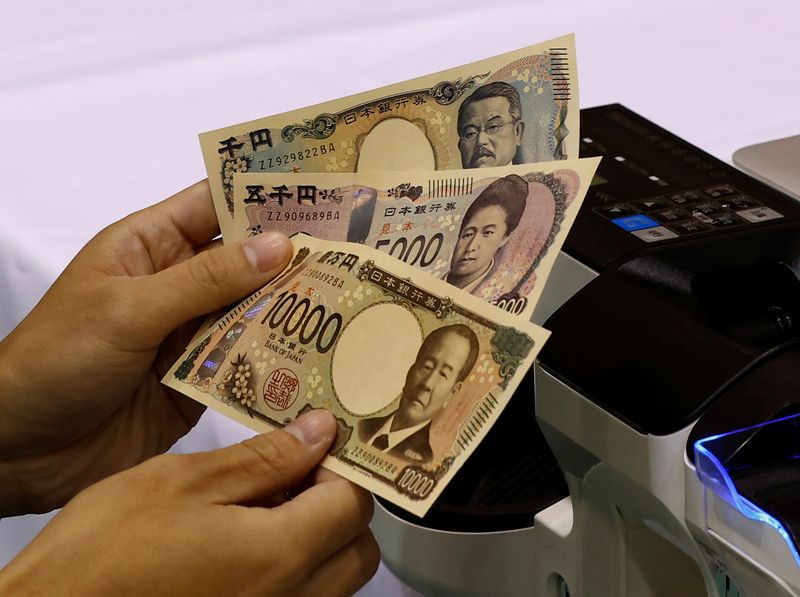By Leika Kihara
TOKYO (Reuters) -Japanese authorities are facing renewed pressure to combat a sustained depreciation in the yen, as traders drive down the currency on expectations that any further interest rate hikes by the central bank will be slow in forthcoming.
Below are details on how yen-buying intervention works:
LAST CONFIRMED YEN-BUYING INTERVENTION?
Japan bought yen in September 2022, its first foray in the market to boost its currency since 1998, after a Bank of Japan (BOJ) decision to maintain its ultra-loose monetary policy drove the yen as low as 145 per dollar. It intervened again in October after the yen plunged to a 32-year low of 151.94.
WHY STEP IN?
Yen-buying intervention is rare. Far more often the Ministry of Finance has sold yen to prevent its rise from hurting the export-reliant economy by making Japanese goods less competitive overseas.
But yen weakness is now seen as problematic, with Japanese firms having shifted production overseas and the economy heavily reliant on imports for goods ranging from fuel and raw materials to machinery parts.
WHAT HAPPENS FIRST?
When Japanese authorities escalate their verbal warnings to say they "stand ready to act decisively" against speculative moves, that is a sign intervention may be imminent.
Rate checking by the BOJ - when central bank officials call dealers and ask for buying or selling rates for the yen - is seen by traders as a possible precursor to intervention.
WHAT HAPPENED SO FAR?
Finance Minister Shunichi Suzuki told reporters on March 27 that authorities could take "decisive steps" against yen weakness - language he hasn't used since the 2022 intervention.
Hours later, Japanese authorities held an emergency meeting to discuss the weak yen. The meeting is usually held as a symbolic gesture to markets that authorities are concerned about rapid currency moves.
After the meeting, Japan's top currency diplomat Masato Kanda said recent yen moves were too rapid and out of line with fundamentals, suggesting Tokyo saw enough reason to intervene to arrest further declines in the currency.
The warnings have kept the dollar from breaking above the psychologically important 152 yen level until Wednesday, when the release of strong U.S. inflation data pushed the pair up above 153, the highest since 1990.
LINE IN THE SAND?
Authorities say they look at the speed of yen falls, rather than levels, and whether the moves are driven by speculators, to determine whether to step into the currency market.
Japan's former top currency diplomat Tatsuo Yamazaki has told Reuters authorities will likely intervene if the yen breaks out of a range it has been in for years and falls well below 152 per dollar. Another ex-currency diplomat, Hiroshi Watanabe, put the line-in-the-sand at 155.
WHAT'S THE TRIGGER?
The decision is highly political. When public anger over the weak yen and a subsequent rise in the cost of living is high, that puts pressure on the administration to respond. This was the case when Tokyo intervened in 2022.
If the yen's slide accelerates and draws the ire of media and public, the chance of intervention would rise again.
The decision would not be easy. Intervention is costly and could easily fail, given that even a large burst of yen buying would pale next to the $7.5 trillion that change hands daily in the foreign exchange market.
HOW WOULD IT WORK?
When Japan intervenes to stem yen rises, the Ministry of Finance issues short-term bills, raising yen it then sells to weaken the Japanese currency.
To support the yen, however, the authorities must tap Japan's foreign reserves for dollars to sell for yen.
In either case, the finance minister issues the order to intervene and the BOJ executes the order as the ministry's agent.
CHALLENGES?
Japanese authorities consider it important to seek the support of Group of Seven partners, notably the United States if the intervention involves the dollar.
Washington gave tacit approval when Japan intervened in 2022, reflecting recent close bilateral relations. There is uncertainty on whether the same will happen when Japan next considers intervention.

A looming U.S. presidential election may discourage Japanese authorities from stepping in, given the risk of drawing unwanted attention and criticism from Washington as market meddling.
There is no guarantee intervention will effectively shift the weak-yen tide, which is driven largely by expectations of prolonged low interest rates in Japan. BOJ Governor Kazuo Ueda has dropped signs of another rate hike but stressed that the bank will tread cautiously given Japan's fragile economy.